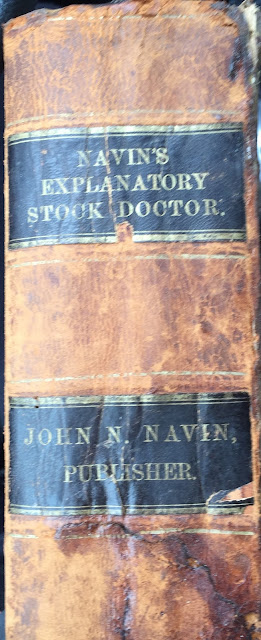Having an estate sale? You have my attention.
An estate sale at the home of people who kept horses during the 1950s? Yes. please.
This morning's estate sale was on a "horse property" of a little over an acre, in suburban Los Angeles (which used to be a very, very horsey place). I had looked at the photos promoting the sale on the internet, and noticed that there only seemed to be a handful of small, rather nondescript Made In Japan (MIJ for short) ceramic horse and dog figurines for sale.
But, at a sale like that, you never know what else might be there of interest to the independent equine history researcher, that didn't make it into the photographs.
The MIJs were overpriced so I left them there, and I didn't see any other model horses or even horse magazines for sale. However, buried in a plastic bin full of old Bibles and cookbooks was a very old, very thick book. I picked it up and examined the spine.
Navin's Explanatory Stock Doctor, it was called. The 1879 publication date really caught my attention.
And indeed, Dr. Navin had entered his book "In the Office of the Librarian of Congress, at Washington," in the year 1864.
I'll tell you more about the book in a separate post. For now, I want to share a couple of the pieces of cardstock that were tucked inside.
The first was an advertisement from the Danville Buggy Company, of Danville, Illinois. I went online and found mentions of this business from 1884 to 1911.
And there was a flyer advertising the services of
DUKE
THE GENERAL PURPOSE HORSE,
KNOWN AS THE PATTERSON HORSE.
(Duke's owner should have hired a proofreader.)
DESCRIPTION
DUKE io a beautiful bright sorrel with white marks on hind feet is a neat compact horse weighing over 1400 pounds in fair flesh, with strong bone, has splendid action and good style, and is a remarkable sure foal getter.DUKE was sired by an imported English Suffolk, Dam an English Hunter.
Duke's owner and keeper, G. D. Rowand, apparently lived in or near Sidell, Illinois. I found references online to a man with that name having owned prize-winning hogs and a pacer named David R..
And according to the March 14, 1902 Bloomington, Illinois Weekly Pantagraph, a G. D. Rowand from Sidell had recently "returned from a trip to South Africa on a British transport loaded with 1,000 mules. He went as an assistant veterinarian." (Tens of thousands of horses and mules were shipped from the US to South Africa for use by British soldiers fighting the Boer War.)
There was no date on the flyer. I wonder if Mr. Rowand owned Duke before, during, or after his service as an assistant veterinarian? Did Duke or any of his offspring serve in South Africa? Might this old copy of Navin's Explanatory Stock Doctor have belonged to Rowand, or one of his neighbors? We'll probably never know.
But now we know there was a horse named DUKE, and someone liked him enough to have saved this small scrap of information with his chunky image on it.








No comments:
Post a Comment